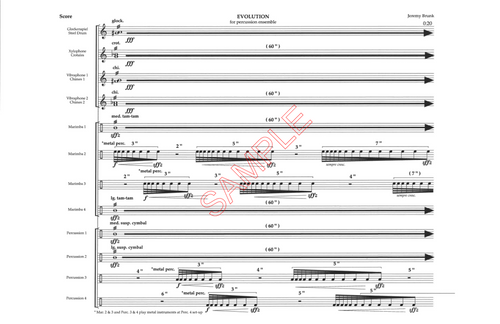Includes score and parts.
Composition 75 for marimba quartet was composed in 1998 as an homage to the micropolyphonic works of György Ligeti, and premiered at the 2000 Midwest Composers Symposium by the University of Illinois Percussion Ensemble.
Want it now? Click here to purchase a digital copy of this product.
Review from Percussive Notes (2022):
Composition 75
Jeremy Brunk
Composed as an homage to the micropolyphonic works by György Ligeti, “Composition 75” is a texturally complex marimba quartet that was premiered at the Midwest Composers Symposium in 2000. Any ensemble wishing to tackle this work will need players with a solid sense of pulse as well as command over a variety of rhythmic subdivisions.
The piece is basically a stacking of polyrhythms. Almost every bar (for that matter, almost every beat) consists of a sixteenth-note based rhythm against a triplet-based rhythm against a quintuplet-based rhythm. Along with this texture is usually a longer musical line that is rolled (the composer notes that all quarter notes and longer should be rolled). At the indicated tempo of 75 bpm, this polyrhythmic effect creates an interesting texture combined with the almost pan-tonal harmonic nature of the piece.
Musically, much of the focus of the piece is on the longer lines that are rolled. The composer clearly indicates dynamic shifts, so it is always apparent which players are the focus. Almost the entire first half of the work explores this texture until the longer rolled voices begin to expand to three- and four-note rolled chords. Jeremy Brunk also indicates bar striking areas at times to show notes moving between the node and a more resonant playing area. A moment exists where all players are rolling longer note-valued chords before a single player breaks into rhythmic ideas similar to the beginning of the work. Players slowly begin moving back towards that style until the last section, where the polyrhythmic texture from the beginning takes over again.
Due to the lack of breaks in playing for any of the performers, all will be required to use four mallets throughout the work. The biggest challenge is the ensemble playing skills needed to keep the work together. Those looking for a texturally interesting, tonally adventurous, and technically challenging work might find what they’re looking for here.
At just under seven minutes, “Composition 75” would be appropriate for an undergraduate or graduate recital or professional group.
—Brian Nozny
Demo:







